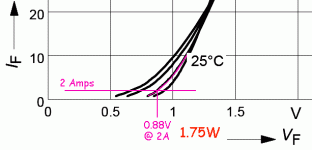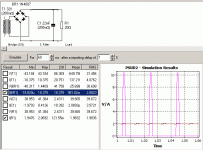I am making an amplifier and have a bunch of these D30E60 diodes. They all test good of course and came out of a Crown CDI 1000 SMPS section. I'm just wondering if I can put them to use and use them to make a bridge rectifier.
Datasheet link
D30E60 Datasheet PDF - Infineon
Datasheet link
D30E60 Datasheet PDF - Infineon
Awesome, thank you. These diodes are a bit weird so I just wanted to make sure before I powered it up.
Awesome, thank you. These diodes are a bit weird so I just wanted to
make sure before I powered it up.
Remember that you'll need isolated heat sinking, since those tabs are live.
Last edited:
Will do. Would they really need a heatsink if I'm just running 40V 1 or 2 amps through them though? I'm assuming the only way to know though is measuring the temperature on the case, correct?
.... Would they really need a heatsink if I'm just running 40V 1 or 2 amps through them though?...
At 2 Amps the forward voltage is around 0.9V. So 1.8 Watts.
Thermal resistance, junction - ambient, leaded RthJA - - 62 K/W
So 1.8W*62C/W is 112 degrees C rise, easily 140 deg C in a warm room inside a warm box.
This will burn flesh at a touch.
Tjmax is 175 deg C so it is technically within ratings.
Um . . no, the power dissipation is right there in the data sheet -- Vf * If -- about 3/4 of a volt at 1 or 2 Amps. So about 1-1/2 Watts, which a TO-220 package can dissipate with no, or minimal - say a short 'flag' or some such - heat sink, and stay well below the 175C temp limit.
The graph needs a little guess-timating 'cause the part is so massively overrated for 40V and an Amp or two. If you want to drop these into a prototype or test setup, sure. But they really deserve an off-line switching regulator secondary to show their excellent performance. You could probably sell these on eBay, and with the proceeds buy 5 or 10 times as many rectifiers better-suited for your application. There are leaded Schottkys, for example, that would run at least nominally cooler; 3 - 5A, 60 - 100V types range from 40 to 65 cents at DigiKey, single quantity.
Maybe its just me, but I wouldn't put up with the inconvenience of the TO-220 package if I didn't really need it, and for a couple Watts, you don't.
How many of these D30E60's do you have, anyway? There's probably somebody on here that could put them to good use.
Also, if you use these at line frequency, you'll probably need the services of Quasimodo (or one of the variants) described in another couple threads on here. The much higher-than-necessary capacitance will produce a much lower ringing frequency.
Edit: I'll defer to PRR's expertise -- pay less attention to this answer.
Regards,
Rick
The graph needs a little guess-timating 'cause the part is so massively overrated for 40V and an Amp or two. If you want to drop these into a prototype or test setup, sure. But they really deserve an off-line switching regulator secondary to show their excellent performance. You could probably sell these on eBay, and with the proceeds buy 5 or 10 times as many rectifiers better-suited for your application. There are leaded Schottkys, for example, that would run at least nominally cooler; 3 - 5A, 60 - 100V types range from 40 to 65 cents at DigiKey, single quantity.
Maybe its just me, but I wouldn't put up with the inconvenience of the TO-220 package if I didn't really need it, and for a couple Watts, you don't.
How many of these D30E60's do you have, anyway? There's probably somebody on here that could put them to good use.
Also, if you use these at line frequency, you'll probably need the services of Quasimodo (or one of the variants) described in another couple threads on here. The much higher-than-necessary capacitance will produce a much lower ringing frequency.
Edit: I'll defer to PRR's expertise -- pay less attention to this answer.
Regards,
Rick
Last edited:
...The graph needs a little guess-timating 'cause the part is so massively overrated...
Yes, we squint, but we may be squinting smaller than the factory draftman felt he was paid to squint.
Squinting too small, I now claim I see 0.88V at 2A. 1.75W. Yes, a naked TO220 can throw this for many hours. But don't put your finger on it! Or bet that it will be problem-free for years. IMHO, the failure of a slow-cooked rectifier may be Dead Short, smoking your transformer. Maybe while you are away, panicking your lover or dog.
(Yes, voltage drop is lower when the chip gets HOT. The effect is small and I prefer to ignore it for added conservatism.)
BUT: if the load is really 2A *DC*, the RMS value of the spikes is higher. PSUD figures 2.9A AC RMS for a 2A DC demand. This is pushing 2.5W-3W which is early-death for a naked TO220.
Attachments
+1 PRR, and apologies, sir -- I'd have gladly left it to your post #6, but I didn't see it 'til I'd already clicked 'Post Quick Reply' (on what became post #7). Then threw in the Edit intending to mean, 'Forget what I said -- follow PRR's advice', but it wasn't clear (that my #7 was aimed at post #5).
Agree heartily that 'too hot to touch is too hot'.
Also on point, the reminder that house mates would likely have a different view of a spectacular failure.
Regards,
Rick
Agree heartily that 'too hot to touch is too hot'.
Also on point, the reminder that house mates would likely have a different view of a spectacular failure.
Regards,
Rick
What's the AC voltage that you want to rectify? Those diodes are rather high VRRM, whose VF usually is higher than for lower voltage diodes. So you might save power losses and heat and have higher output power if you chose the rectifiers accordingly.
Best regards!
Best regards!
What's the AC voltage that you want to rectify? Those diodes are rather high VRRM, whose VF usually is higher than for lower voltage diodes. So you might save power losses and heat and have higher output power if you chose the rectifiers accordingly.
Best regards!
The voltage is about 32v with only a few amps. I have set them up using a prototype board, everything seems to be connected correctly I only have 40v DC after the filter capacitors, from my quick research that seems to be okay. I'll post pics soon for those interested. This power supply will be used to power 2 LM 3886's that I'm using in a Toshiba SB 420.
I also have a bunch of 1n4004 diodes but figured they aren't big enough but maby can be used for the tone control circuit.
Last edited:
Hard to picture what use they'd be in a tone control, but 1N4004's are widely used, fairly rugged, and not frequently blamed for a failure.
I'd sure rather see these paired, eight to a bridge, than throwing away money, and high-performance parts, like your D30E60's on a 1 or 2 Amp supply.
If you need more current, pick out some 3 or 5 Amp, 50V Schottky's and get higher output voltage, and lower temp rise -- better reliability -- than the high-voltage, high-speed D30E60's.
Sure, you could use them, but it'd be a sad waste of some genuinely high-performance parts' potential. They really belong in an off-line converter or power factor correction circuit.
There's a very big gap (performance-wise) between 1N4004's and your D30E60's.
Regards,
Rick
I'd sure rather see these paired, eight to a bridge, than throwing away money, and high-performance parts, like your D30E60's on a 1 or 2 Amp supply.
If you need more current, pick out some 3 or 5 Amp, 50V Schottky's and get higher output voltage, and lower temp rise -- better reliability -- than the high-voltage, high-speed D30E60's.
Sure, you could use them, but it'd be a sad waste of some genuinely high-performance parts' potential. They really belong in an off-line converter or power factor correction circuit.
There's a very big gap (performance-wise) between 1N4004's and your D30E60's.
Regards,
Rick
- Status
- Not open for further replies.
- Home
- Amplifiers
- Power Supplies
- Can I use D30E60 diode for a bridge rectifier?

